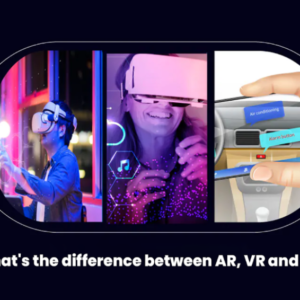The wide variety of devices is important to take into consideration when designing for the web. Designing responsive websites ensures that your designs are accessible to users regardless of device, and it helps maintain visual unity across all displays. Not only will it help you reach a larger audience, but designing in this way ensures visual unity across all devices, regardless of size. Relying on an experienced and proficient website development company can aid you with an infallible responsive website tendering convincing trending designs, delivering easy navigation & exceptional user experience. As the internet continually evolves, so do the trends in web design.
Website development company know that the technology advancement has led them to many futuristic opportunities, this applies for users as well.
A modern responsive design using new and innovative UI design trends is a great way to stay ahead of the curve and create a truly captivating experience for both desktop and mobile users. You may be wondering exactly what a responsive design is or how to create one. There are several responsive web design trends here you can use as inspiration. I’ll give you real-life examples of how you can use them.
What is Responsive Web Design?
Designing a website that will look good regardless of screen size, browser window, or device is known as responsive design. It’s an effective way to keep your website traffic up and increase conversions. Responsive design is a method of creating websites that are easy to use for anyone, anywhere. It helps make your website accessible to mobile and tablet users without a hitch.
Responsive design enables websites and User Interface (UI) to cater to the preferences of its users by dynamically re-organizing elements that occupy the interface. Its main objective is to maintain a good user experience by allowing content to adjust based on the viewing size.
It improves the overall user experience by tailoring a website or app’s interface to offer optimal viewing no matter what platform it is being used, based on the concept that looks to create optimal cross-device functionality. It encourages the use of pixels and fluid layouts in order to ensure content is adaptable, allowing the UI to adjust itself whenever the device of the user changes.
With this, we don’t have to create separate designs and sites for each type of device, but can rather design one site that automatically works well across multiple platforms.
Why is Responsive Design So Important?
Responsive web design provides an optimal viewing experience across multiple devices. It’s a flexible approach to web design and development that uses fluid layouts, CSS media queries, and other strategies to provide an optimal viewing experience across a wide range of devices.
Done right, responsive web design is a powerful tool that can engage users across devices. But before you jump into the deep end with RWD, it’s important to understand your personas and objectives. There are several different strategies for designing responsively, and they each have their place. See how we turned these fun facts into a cute fact list using icons, quotes, and varying lengths.
We want to make sure people don’t see the same content that is optimized for a larger screen. By making sure your text is not resizable, you make sure they get the best experience possible and keep users interested in your content, which can keep them on your site longer.
Although your website looks great on a desktop computer, it’s equally important that your site is easy to read on mobile phones. Hence without a responsive web design, anyone who views your content on a smartphone, tablet, or other devices that you did not plan and design for will probably feel alienated. This is because there are simply too many links and buttons to ensure that your content is still easy to consume.
Responsive Web Design Trends
Responsive web design is quickly becoming the standard, particularly for new websites. One exciting emerging trend is the rise of vector graphics and icon fonts. Vectors are resolution-independent since they aren’t rasterized at various sizes like bitmap images are. They’re also typically smaller in file size than rasterized graphics since resolution-dependent images can end up containing a lot of pixels that don’t change as the size of the image is adjusted.
Vector Graphics
Today, with the growing demand for interactive websites where users can adjust the size of the screen according to their needs, a new wave of graphics has become more and more popular. Vector graphic design is a method based on mathematical calculations that allow the designer to create graphic elements that will maintain their quality no matter the size they are scaled to.
Vector graphics are used to represent lines, designs, or characters that remain sharply defined when resized. They originated for computer-based design work and are often used on the web because they will not distort when resized like bitmap images. Vector designs are perfect for use on the web. They can be enlarged or shrunk without pixelation by using mathematical coding, a technique commonly used in print design to enlarge an image without losing its clean lines and distinct shapes.
Adding CSS queries
A responsive web design is a design that can adapt to multiple screen sizes and work optimally across desktop computers, tablets, and mobile devices. Adding media queries to your CSS style sheet is a great way to create breakpoints based on various screen sizes, which allows you to control how the design will look in different states. They are a great way for designers to tell the web browser how to render different elements on different viewports. They allow you to create breakpoints based on various screen sizes, which allows you to control how the design will look in different states.
Adding CSS media queries to your CSS style sheet lets you make changes to the content layout based on the visitor’s screen size and orientation. For example, you can create a breakpoint that will display a different layout for devices with screens smaller than 480 pixels. This is especially important on mobile devices, where you might want to display more information on-screen at any given time in order to provide a better experience.
Using layouts and grids
When using layouts and grids, it is important to consider screen size variations. In order to provide a good user experience, a separate style sheet should be created that will resize on smaller screens. It is crucial to ensuring that everything in your design looks the same, no matter what device it’s being viewed on. This means that you’ll need to factor in a certain amount of width to accommodate for varying screen sizes. A common way to make your design work on different devices is to use a separate style sheet and check the size of the screen before you place the content.
This way, you can control how your website looks across devices with more ease. To create flexible layouts, designers will often create a mobile stylesheet to switch on if the layout becomes too small for the screen. If you haven’t already, set up a style sheet that will detect and switch to a layout suited for the device you are using. Designing a website is not the art of cramming all of your content into a tiny space. It’s creating a beautiful and cohesive layout that looks good on every device.
Making sure images are also responsive
When you create images that will be viewed under multiple devices, each device has its own screen size. Without editing anything, the image could take up most of the screen space. This would mean showing the picture only. To prevent this, attribute a max-width percentage to your image and use CSS to resize the image.
If a user visits your website using a mobile device then image sizes need to adjust accordingly so that they don’t take up more than 50-80% of screen space otherwise known as the “viewport.” This way users can still view and navigate around the site on different devices, while at the same time looking good.
One way to control the amount of space an image takes up on your webpage is by using responsive images. This type of image will change the size of the image depending on how large or small your screen is. Responsive images on the web determine the size of the image that displays depending on what device your audience is using to view the site. Any mobile device will show a smaller version of the image than desktop devices.
Stop cluttering
Minimalist design is an interesting approach to web design that is becoming more and more popular. Designers are using a minimalistic approach to avoid the jarring experiences that some users have when elements appear and disappear between breakpoints. Minimalist designs can be seen everywhere. Some companies have even made the style one of their branding initiatives. These companies pay careful attention to the spacing of text, graphics, and navigation to create an attractive presentation on the web that is attention-grabbing at first sight.
When you’re balancing multiple design elements, some may fit nicely in all screen sizes while others may push content below the fold. Prioritize your web design elements and create a responsive web design that adapts to different screen sizes. Prioritize elements of your design to make sure the layout will look great no matter how much or how little screen real estate a user has.
For example, a larger screen may have enough room to show a full-width image, while a smaller screen may need inline copy to replace the image. As you’re designing for multiple devices, know which elements are most important to your business and prioritize them in relation to screen size.
Use Responsive Web Design Tools
The best way to ensure the quality of your mobile website is to test it across a multitude of devices. If you’re targeting the emerging markets, or those who primarily browse via their mobile phones, how can you make sure to give them a good user experience? With LT Browser, you have the ability to test your responsive website design across 50+ different device viewports like mobiles, tablets, desktops and laptops.
Every designer knows that responsiveness is one of the most important aspects for website design. Unfortunately, it’s very hard to test how your website behaves on mobile devices as you need to have a lot of them around. LT Browser is one such tool that helps you create high-quality websites to test its look and feel perfect regardless of the device.
LT Browser is a responsive testing tool for websites and web apps that enables you to see what your website looks like on a variety of device viewports. It also allows you to test your site without leaving any fingerprinting. This is very beneficial when testing for responsive sites, as it allows you to view how your design works for desktop users as well as people viewing your site on mobile devices.






